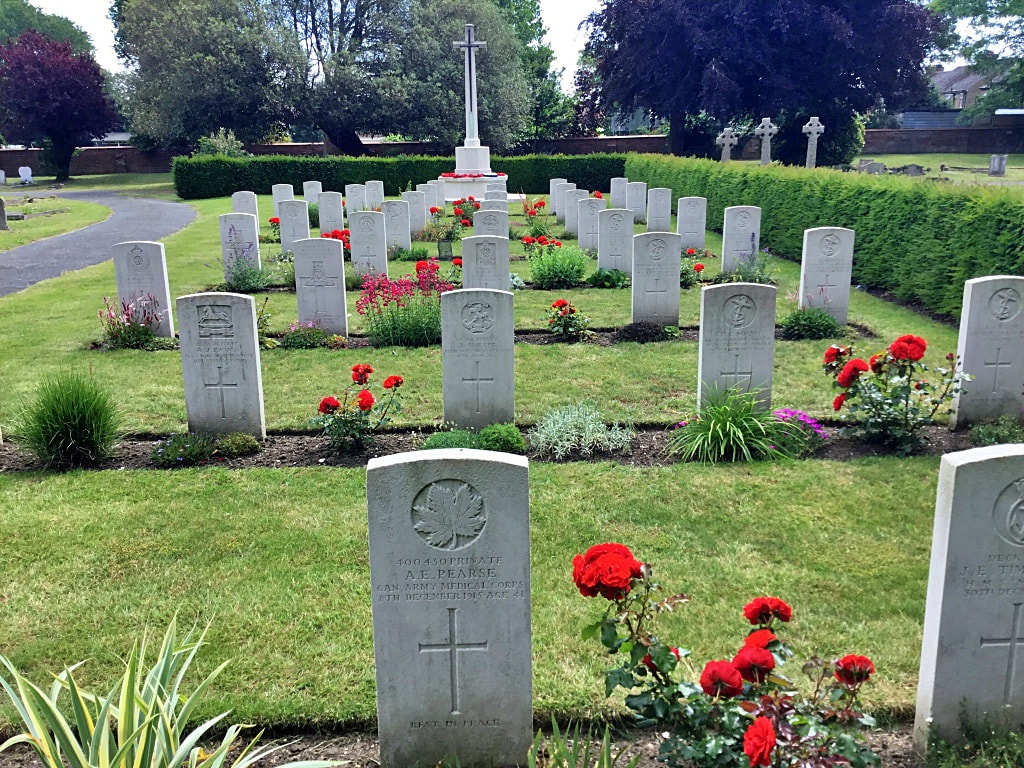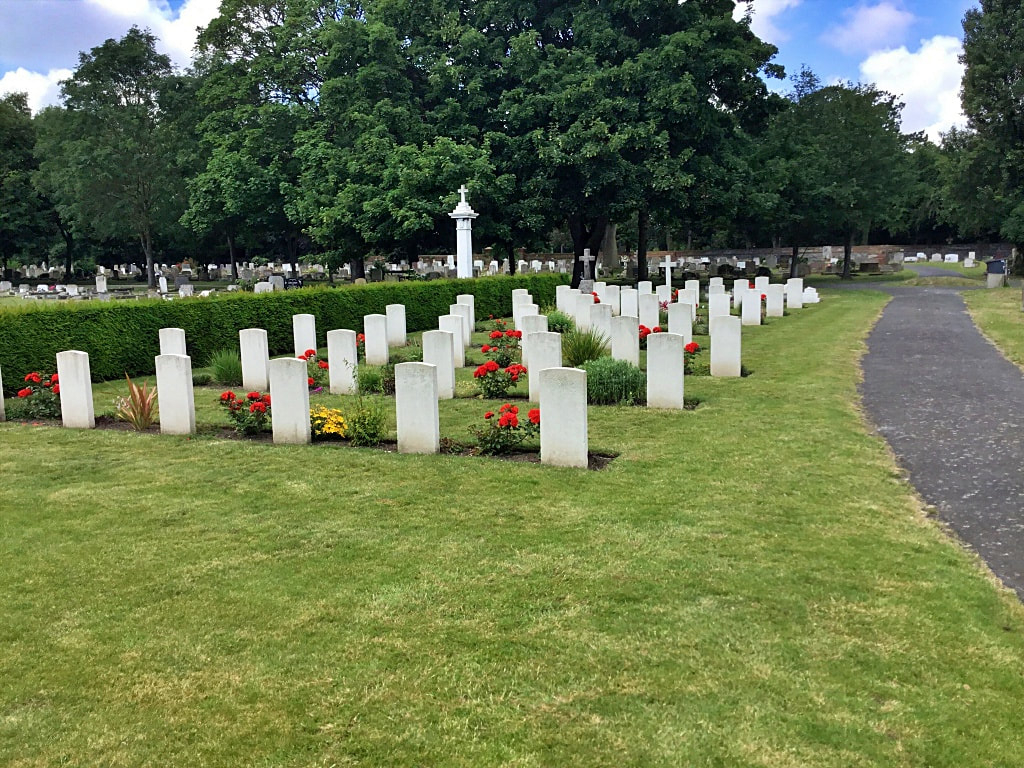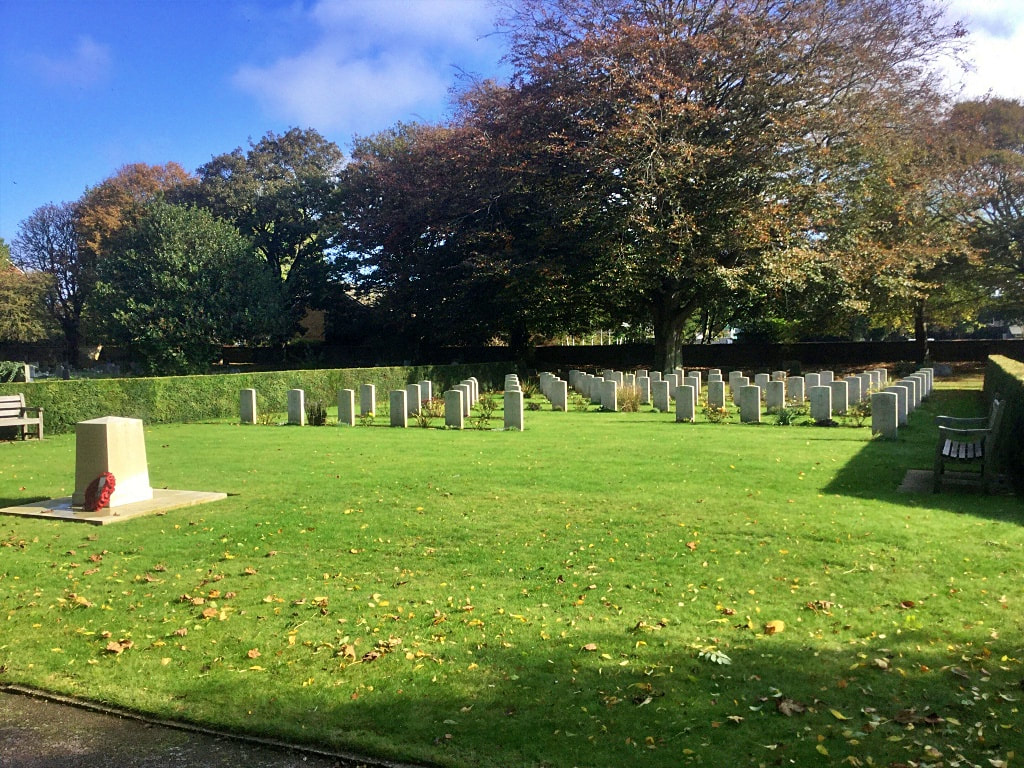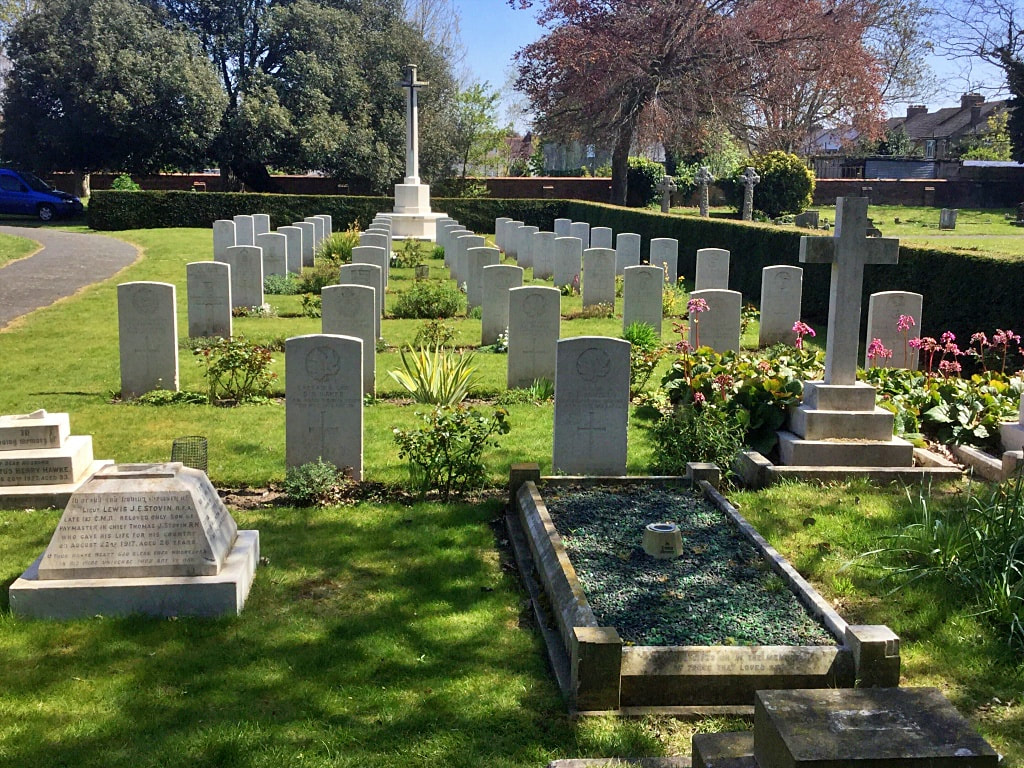RAMSGATE CEMETERY
Kent
England
GPS Coordinates: Latitude: 51.34263, Longitude: 1.42088
Location Information
Ramsgate Cemetery is located to the North of the town off Cecilia Road.
Historical Information
During the First World War Ramsgate was the base of armed drifters and held a Canadian Special Hospital. The town was bombed in March 1916.
Ramsgate Cemetery contains 102 First World War burials, almost half of them forming a war graves plot. Six of the burials are unidentified. Close to the plot are the graves of 13 men of HMTB'4' who were killed in an explosion in May 1917.
Ramsgate was a naval station during the Second World War and one of the ports controlling the initial despatch of volunteer vessels for the evacuation of the British Expeditionary Force from Dunkirk in 1940. Nearby Manston aerodrome, a Royal Air Force fighter airfield, was attacked several times during the Battle of Britain and was put out of action for a period. The cemetery was used by the aerodrome and by Ramsgate General Hospital.
Second World War burials in the cemetery number 88, six of them unidentified. Most of these graves form a second plot which also contains eleven German and one Dutch grave.
Total Commission Burials: 205.
World War One Casualties: United Kingdom 83, Canada 12, Australia 1. Total 96.
World War Two Casualties: United Kingdom 82, Germany 11, Netherlands 1. Total 94.
Images in the gallery below used with the permission of the Commonwealth War Graves Commission

Captain
Basil Rupert Baker
Canadian Army Medical Corps
7th May 1917, aged 39.
LB. 16.
Son of C. H. Coryndon Baker, of Hook, Hampshire, England. Served in France with the 22nd Bn. Canadian Inf. (Quebec Regt.).
His headstone bears the inscription "Lamented By Daughter Lyndon Evelyn Baker"
The information below supplied by 'The Ellesmerian Club', the alumni organisation for Ellesmere College where Basil was a pupil.
Basil Rupert Baker
Canadian Army Medical Corps
7th May 1917, aged 39.
LB. 16.
Son of C. H. Coryndon Baker, of Hook, Hampshire, England. Served in France with the 22nd Bn. Canadian Inf. (Quebec Regt.).
His headstone bears the inscription "Lamented By Daughter Lyndon Evelyn Baker"
The information below supplied by 'The Ellesmerian Club', the alumni organisation for Ellesmere College where Basil was a pupil.
Basil Rupert Baker was an ‘Aborigine’ – the name given to those who entered Ellesmere College on 8thSeptember 1884, the very first term that the college was open for business. The Woodard Corporation had determined that “this school is intended for the sons of professional men of narrow means, tradesmen, farmers and others to whom education at a small cost is necessary. The expenses of board, education and washing are fixed at eighteen guineas a year.” The Governing Body stressed to prospective parents that: “It must be obvious to all who read this prospectus that the charge of eighteen guineas a year can provide only plain substantial food.”
During that first term, one hundred and seven pupils were admitted and Basil, accompanied by his elder brother, Bernard, was placed in the ‘Conqueror’ dormitory and took up his desk in Form Upper I. Basil was just nine years old having been born in Westmorland on 27th June 1875 (although some records indicate 1878). At the time of the brothers’ arrival in Shropshire their father, the Reverend Charles Henry Coryndon Baker was incumbent at St. John’s Vicarage. In 1880, their mother, Lyndon Emily gave birth to a younger sister, Grace. Another child, Lyndon Evelyn, died in infancy in 1884.
The records of the college at this time are few and far between but mention is made in various editions of The Ellesmerian that Basil played cricket and rugby for his dormitory. On Sports Day 1887 it was recorded that he took 2nd place in the One Mile Flat Race. The report of the time commented that in this race “second and third places were won by small fellows with large starts”. In Basil’s case he had a 130 yard advantage at the start of the race.
Also in that year he was awarded a ‘Wakeman Scholarship’. These were three in number and were “open for competition to boys under twelve-and-a-half years of age who have been in S. Oswald's College for the previous year and half, enabling them to proceed to S. Chad's, Denstone, at the cost of £15 15s. per annum, for board and education”.
Basil left the college on 20th December 1889 when just fourteen years old. It would appear, however, that he never attended Denstone College – there is no entry for him in the comprehensive Denstone Register 1873-1930.
Shipping records record that a ‘Basil Rupert Baker, Engineer’ travelled to Capetown, South Africa on the ss Damascus but there is no other evidence to corroborate that this is our man. However, it is known that Basil was in South Africa around this time as, in July that year, he returned to England on ss Tamar accompanied by a Miss Annie Christina Kellie, a woman of Irish birth who was resident in Johannesburg. They arrived at Southampton on 6th July and married on 1st September 1896 at All Saint’s Church, Scarborough where Basil’s father officiated at the service.
As Basil was recorded as serving in the Second Boer War it would be logical to presume they returned to South Africa. Basil served in both the 1st Scottish Horse (Service No. 36936) and the Marshall’s Horse (Service No. 559) with the units being raised in 1899 and 1900 respectively. Initially, he was a Corporal, later records indicate he was commissioned and held the rank of Lieutenant. It is not known exactly where or when he saw active service but he was awarded the Queen’s South Africa Medal with clasps for service in the Transvaal, the Orange Free State and Cape Colony.
Basil was in England at the time of the 1901 Census and resident at Newnham Rectory where his father was now incumbent. On this document he was recorded as a ‘Corporal, Marshall’s Horse’, twenty six years old and ‘single’.
Two years later his marriage to Margaret Maud Muriel Arundel was recorded on 2nd May 1903 at Westminster, London. A daughter was born in 1905. Basil returned to Canada and joined the regular army there. He was eventually posted to the staff at the Adjutant-General’s Department at Ottawa, and during a period of duty extending over several years he “established a reputation as an officer with unusual ability as an organiser”.
When war broke out Basil would have been 39 years old but he lost no time at all in enlisting with the Canadian Expeditionary Force and on 20th October 1914, he signed his Attestation Papers in Quebec and became Private Baker, Service No. 61001. On these documents he declared he was, at that time, a professional soldier and had served with the Permanent Force of Canada for the previous six years. This would indicate he had been in Canada since 1908. He also stated he had served in South Africa for three years and that his next of kin was his father, by now incumbent at Newnham Rectory, Hertfordshire.
Basil was posted to the 22nd Battalion (Infantry), the Quebec Regiment and underwent his training prior to embarkation on the troopship HMT Saxonia on 20th May 1915. Whilst on board he was appointed Regimental Quarter Master with the Honorary Rank of Lieutenant.
The unit arrived in England and, nearly four months later, they dis-embarked at Boulogne on 15th September. In France the battalion “was engaged in much fierce fighting, particularly in the operations at Courcellette in which the colonials distinguished themselves by some particularly brilliant and gallant work”.
A month later the conditions at the Front took their toll and Basil was diagnosed as suffering from bronchitis and initially admitted to the Rawal Pindi British General Hospital at Wimereux. Two days later, he was transported back to England on HMT Cambria and admitted to Mill Pollock’s Hospital, Weymouth Street, London where "Treatment consisted of rest and a simple cough mixture. His chest is badly developed."
By the end of November that year he attended a Medical Board and was declared fit for general service and posted to the 23rd Battalion. Interestingly, this document records that then had ten years military service behind him which would indicate he had moved to Canada in 1905.
On 6th February 1916, he formally relinquished his temporary rank of Lieutenant as he was then promoted Honorary Captain, the Canadian Army Medical Corps and detailed to the Canadian Hospital at Ramsgate.
Unfortunately, he became ill again and was admitted to this hospital as an in-patient on 29th April 1917 suffering from pneumonia. He died on 7th May and the Thanet advertiser described that his funeral was “attended by a large body of the deceased’s comrades on the staff of the Canadian hospitals in the town and by contingents representing the Imperial Services. The body was removed to the burial ground on a gun carriage, provided by the R.F.A. and drawn by six horses, with subalterns acting as drivers. Three beautiful wreaths and deceased’s cap and belt were laid on the casket, which was draped with the Union Jack. Other floral tributes were carried by NCO’s of the C.A.M.C. The officer’s charger, led by his orderly, followed immediately behind the coffin. An escort and firing party, marching with arms reversed, was supplied by the Northumberland Fusiliers. The Navy was represented by a party of officers, among whom were Lieut. Commander Williams and Lieut. H. J. West; and by a squad of bluejackets under P.O. Clemens. There were also detachments from the Royal Engineers and the R.N.A.S. Seaplane Base”.
Basil was buried in Ramsgate cemetery and his grave is, to this day, maintained by the Commonwealth War Graves Commission. His estate was left to the care of Elizabeth Ann Roebuck, the guardian of his daughter.
During that first term, one hundred and seven pupils were admitted and Basil, accompanied by his elder brother, Bernard, was placed in the ‘Conqueror’ dormitory and took up his desk in Form Upper I. Basil was just nine years old having been born in Westmorland on 27th June 1875 (although some records indicate 1878). At the time of the brothers’ arrival in Shropshire their father, the Reverend Charles Henry Coryndon Baker was incumbent at St. John’s Vicarage. In 1880, their mother, Lyndon Emily gave birth to a younger sister, Grace. Another child, Lyndon Evelyn, died in infancy in 1884.
The records of the college at this time are few and far between but mention is made in various editions of The Ellesmerian that Basil played cricket and rugby for his dormitory. On Sports Day 1887 it was recorded that he took 2nd place in the One Mile Flat Race. The report of the time commented that in this race “second and third places were won by small fellows with large starts”. In Basil’s case he had a 130 yard advantage at the start of the race.
Also in that year he was awarded a ‘Wakeman Scholarship’. These were three in number and were “open for competition to boys under twelve-and-a-half years of age who have been in S. Oswald's College for the previous year and half, enabling them to proceed to S. Chad's, Denstone, at the cost of £15 15s. per annum, for board and education”.
Basil left the college on 20th December 1889 when just fourteen years old. It would appear, however, that he never attended Denstone College – there is no entry for him in the comprehensive Denstone Register 1873-1930.
Shipping records record that a ‘Basil Rupert Baker, Engineer’ travelled to Capetown, South Africa on the ss Damascus but there is no other evidence to corroborate that this is our man. However, it is known that Basil was in South Africa around this time as, in July that year, he returned to England on ss Tamar accompanied by a Miss Annie Christina Kellie, a woman of Irish birth who was resident in Johannesburg. They arrived at Southampton on 6th July and married on 1st September 1896 at All Saint’s Church, Scarborough where Basil’s father officiated at the service.
As Basil was recorded as serving in the Second Boer War it would be logical to presume they returned to South Africa. Basil served in both the 1st Scottish Horse (Service No. 36936) and the Marshall’s Horse (Service No. 559) with the units being raised in 1899 and 1900 respectively. Initially, he was a Corporal, later records indicate he was commissioned and held the rank of Lieutenant. It is not known exactly where or when he saw active service but he was awarded the Queen’s South Africa Medal with clasps for service in the Transvaal, the Orange Free State and Cape Colony.
Basil was in England at the time of the 1901 Census and resident at Newnham Rectory where his father was now incumbent. On this document he was recorded as a ‘Corporal, Marshall’s Horse’, twenty six years old and ‘single’.
Two years later his marriage to Margaret Maud Muriel Arundel was recorded on 2nd May 1903 at Westminster, London. A daughter was born in 1905. Basil returned to Canada and joined the regular army there. He was eventually posted to the staff at the Adjutant-General’s Department at Ottawa, and during a period of duty extending over several years he “established a reputation as an officer with unusual ability as an organiser”.
When war broke out Basil would have been 39 years old but he lost no time at all in enlisting with the Canadian Expeditionary Force and on 20th October 1914, he signed his Attestation Papers in Quebec and became Private Baker, Service No. 61001. On these documents he declared he was, at that time, a professional soldier and had served with the Permanent Force of Canada for the previous six years. This would indicate he had been in Canada since 1908. He also stated he had served in South Africa for three years and that his next of kin was his father, by now incumbent at Newnham Rectory, Hertfordshire.
Basil was posted to the 22nd Battalion (Infantry), the Quebec Regiment and underwent his training prior to embarkation on the troopship HMT Saxonia on 20th May 1915. Whilst on board he was appointed Regimental Quarter Master with the Honorary Rank of Lieutenant.
The unit arrived in England and, nearly four months later, they dis-embarked at Boulogne on 15th September. In France the battalion “was engaged in much fierce fighting, particularly in the operations at Courcellette in which the colonials distinguished themselves by some particularly brilliant and gallant work”.
A month later the conditions at the Front took their toll and Basil was diagnosed as suffering from bronchitis and initially admitted to the Rawal Pindi British General Hospital at Wimereux. Two days later, he was transported back to England on HMT Cambria and admitted to Mill Pollock’s Hospital, Weymouth Street, London where "Treatment consisted of rest and a simple cough mixture. His chest is badly developed."
By the end of November that year he attended a Medical Board and was declared fit for general service and posted to the 23rd Battalion. Interestingly, this document records that then had ten years military service behind him which would indicate he had moved to Canada in 1905.
On 6th February 1916, he formally relinquished his temporary rank of Lieutenant as he was then promoted Honorary Captain, the Canadian Army Medical Corps and detailed to the Canadian Hospital at Ramsgate.
Unfortunately, he became ill again and was admitted to this hospital as an in-patient on 29th April 1917 suffering from pneumonia. He died on 7th May and the Thanet advertiser described that his funeral was “attended by a large body of the deceased’s comrades on the staff of the Canadian hospitals in the town and by contingents representing the Imperial Services. The body was removed to the burial ground on a gun carriage, provided by the R.F.A. and drawn by six horses, with subalterns acting as drivers. Three beautiful wreaths and deceased’s cap and belt were laid on the casket, which was draped with the Union Jack. Other floral tributes were carried by NCO’s of the C.A.M.C. The officer’s charger, led by his orderly, followed immediately behind the coffin. An escort and firing party, marching with arms reversed, was supplied by the Northumberland Fusiliers. The Navy was represented by a party of officers, among whom were Lieut. Commander Williams and Lieut. H. J. West; and by a squad of bluejackets under P.O. Clemens. There were also detachments from the Royal Engineers and the R.N.A.S. Seaplane Base”.
Basil was buried in Ramsgate cemetery and his grave is, to this day, maintained by the Commonwealth War Graves Commission. His estate was left to the care of Elizabeth Ann Roebuck, the guardian of his daughter.
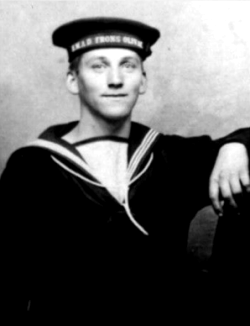
2188/X Seaman
Joseph H. Benoit
H. M. S. Ceto, Newfoundland Royal Naval Reserve
4th May 1915, aged 19.
EA. R.C. 150.
Son of John and Annie Benoit, of Cape St. George, Newfoundland.
His headstone bears the inscription "May My Sailor Boy Rest In Peace"
Joseph H. Benoit
H. M. S. Ceto, Newfoundland Royal Naval Reserve
4th May 1915, aged 19.
EA. R.C. 150.
Son of John and Annie Benoit, of Cape St. George, Newfoundland.
His headstone bears the inscription "May My Sailor Boy Rest In Peace"
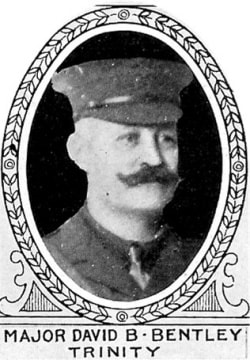
Major
David Benjamin Bentley
2nd Field Ambulance, Canadian Army Medical Corps
5th April 1917, aged 52.
LA. 657.
Son of John and Julia Rogers Bentley; husband of Alice S. Bentley, of 197, Wellington St., Sarnia, Ontario. Gassed at the 2nd Battle of Ypres, 1915.
His headstone bears the inscription "At The Going Down Of The Sun And In The Morning We Will Remember Them"
David Benjamin Bentley
2nd Field Ambulance, Canadian Army Medical Corps
5th April 1917, aged 52.
LA. 657.
Son of John and Julia Rogers Bentley; husband of Alice S. Bentley, of 197, Wellington St., Sarnia, Ontario. Gassed at the 2nd Battle of Ypres, 1915.
His headstone bears the inscription "At The Going Down Of The Sun And In The Morning We Will Remember Them"

1479/X Seaman
William James Brace
H. M. Drifter, Rooke, Newfoundland Royal Naval Reserve
3rd August 1916.
LA. 593.
Son of Richard and Mary Brace, of Chance Cove, Trinity Bay, Newfoundland.
His headstone bears the inscription "We Miss You We Bow In Deep Submission To Our Heavenly Father's Will"
William James Brace
H. M. Drifter, Rooke, Newfoundland Royal Naval Reserve
3rd August 1916.
LA. 593.
Son of Richard and Mary Brace, of Chance Cove, Trinity Bay, Newfoundland.
His headstone bears the inscription "We Miss You We Bow In Deep Submission To Our Heavenly Father's Will"

721948 Private
Archibald John Polson
R. D. Company, Canadian Machine Gun Corps
1st September 1917, aged 21.
LA. 664.
Son of Mr. and Mrs. August Polson of Gimli, Manitoba.
Archibald John Polson
R. D. Company, Canadian Machine Gun Corps
1st September 1917, aged 21.
LA. 664.
Son of Mr. and Mrs. August Polson of Gimli, Manitoba.

